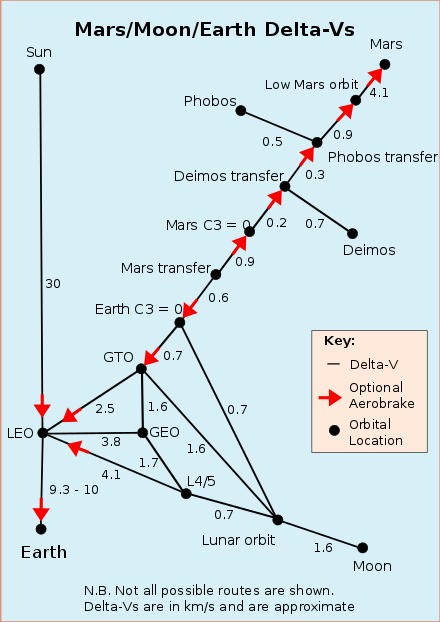Delta-v
Delta v (


where 


Space Dynamics
In spaceflight, delta v, often written out rather than with formula symbols, is a measure of a spacecraft's ability to perform maneuvers. In the simplest case, without gravitational influence, delta v is the integral of the magnitudes of all velocity changes along the desired trajectory. This integral is invariant to the mass of the maneuvering spacecraft, as well as to technical details of its propulsion. The invariance of the quantity has obvious advantages, so that for spacecraft, instead of mass, thrust, and propellant supply, the total delta v (

In the gravitational field, e.g. during launch or during a swing-by, the delta v to be applied by the spacecraft does not correspond directly to any change in velocity, but can nevertheless be calculated as a quantity. However, in the atmosphere and in a non-freefall situation, it additionally depends on the aerodynamic properties of the vehicle and the time required by the spacecraft to reach a stable orbit, i.e. a free-fall situation. For a launch into a Low Earth Orbit, about Δ is 

It should be noted that in this specification the weight of the payload (weight of the people on board / of the spacecraft) has an influence on the available delta v of a spacecraft, since with an increase in mass and thus increased inertia the available delta v becomes smaller. In other words, if the astronauts on the Apollo missions had packed too many moonstones, the required delta v of the ascent stage to reach the mother ship would remain the same, but the delta v that would be available would decrease and fall below the value of the required delta v, making the ascent stage too heavy and the mother ship no longer reachable.
For example, the Δ 
Typical delta v for orbital and interplanetary maneuvers
| Stabilization maneuvers | Rail height | Delta v | |
| type. | max. | ||
| Position stabilization | < 50–55 | ||
| Height stabilization | < 400–500 | <25 | <100 |
| < 500–600 | < 05 | < 025 | |
| >600 | < 007,5 | ||
| One-time maneuvers | Delta v |
| Situation control | 2–06 |
| Rotation control | 5–10 |
| Relief of the position stabilisation gyroscope | 2–06 |
| Separation from the starting stage | 5–10 |
| Uncoupling a spacecraft from theISS | 0,12 |
| Maneuvers for orbit change (see graphic on the right) | Delta v | |
| From | to | |
| Earth's surface | Low Earth Orbit (LEO) | 9.300–10.000 |
| Low Earth Orbit | Geostationary Transfer Orbit (GTO) | 2.500 |
| Geostationary transfer orbit | Geosynchronous Orbit (GEO, GSO) | 1.500 |
| Perigee of the geostationary transfer orbit | Escape Route | 0.700 |
| Escape Route | Low lunar orbit | 0.700 |
| Mars Transfer Orbit | 0.600 | |
| Low Earth Orbit | Surface of Mars | 4.800 |
| Escape route from the solar system | 8.700 | |
| Low lunar orbit | Lunar surface | 1.600 |

Delta v in km/s for various manoeuvres from the Earth to the Moon and Mars
Search within the encyclopedia